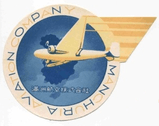Manchuria Aviation Company
 | |||||||
| |||||||
| Founded |
September 26, 1932 Fengtian, Manchukuo | ||||||
|---|---|---|---|---|---|---|---|
| Ceased operations | August 1945 | ||||||
| Hubs | Hsinking | ||||||
| Focus cities | Mukden | ||||||
| Destinations | Domestic, Empire of Japan, Germany | ||||||
| Headquarters | Mukden, Manchukuo | ||||||
Manchuria Aviation Company[1][2][3](traditional Chinese/Kyūjitai: 滿洲航空株式會社; simplified Chinese: 满州航空株式会社; Shinjitai: 満州航空株式会社; Hanyu Pinyin: Mǎnzhōu Hángkōng Zhūshì Huìshè; Wade–Giles: Man3-chou1 Hang2-k'ung1 Chu1-shih4 Hui4-she4 Japanese Hepburn: Manshū Kōkū Kabushiki Gaisha, "MKKK") was the national airline of Manchukuo.
Manchuria Aviation Company was established on 26 September 1931 in Fengtian by order of the Japanese Kwantung Army, out of the Manchurian branch office of Japan Air Transport, the forerunner of Imperial Japanese Airways. It officially adopted the name Manchuria Aviation Company on the proclamation of the independence of Manchukuo. Major shareholders were the Manchukuo government, the South Manchurian Railway Company and the Sumitomo zaibatsu.
From the beginning, the Manchuria Aviation Company was a paramilitary airline, whose primary purpose was to provide transport and logistical support for the military, and for the transport of mail. Civilian passengers were carried and charter operations undertaken on a lower priority.
In 1936, an "Independent Volunteer Battalion" of the MKKK consisting of 13 aircraft fought on the side of the Inner Mongolian Army against Kuomintang-held Suiyuan.[4]
The airline had a "hub" in Hsinking and was linked by regular flight routes from Harbin, Shamussi (Kiamusze), Kirin, Mukden, Antung, Chinchow, Chengde, Tsitsihar, Hailar, and the Kwantung Leased Territory and Korea areas, for connections with Imperial Japanese Airways (Dai Nippon Koku KK) to Japan itself or foreign routes. A long distance route between Hsinking and Berlin was also pioneered in 1938.


The repair shops of the MKKK produced copies of the Fokker Super Universal (Nakajima Ki-6) and the De Havilland DH.80 "Pussmoth"
The Manchuria Aviation Company ceased operations in August 1945 during the Soviet invasion of Manchuria. However, wartime fuel and equipment shortages had previously curtailed its operations considerably. Remaining aircraft, goods and equipment were confiscated, to the benefit of the Soviet Union and Communist Chinese, after the conflict.
Fleet
- 30x Manshū MT-1 Hayabusa airliner
- 27x de Havilland DH.80 Pussmoth
- 15x Messerschmitt Bf 108A/B Taifun liaison aircraft
- 12x Nakajima AT-2 Thora transports
- 10x Mitsubishi MC-20 Topsy transports
- 10x Junkers Ju 86Z-1 transports/bombers
- 10x Junkers Ju 86Z-2 transports/bombers
- 2x Heinkel He 116A communications planes
- 2x Fokker F.VIIb-3m/M transports
- 1x Tachikawa Ki-54 Hickory transport
- 1x de Havilland DH.85 Leopardmoth
- 1x General Aviation GA-43 transport
- ?x Tachikawa Type LO Thelma transport (license build Lockheed Model 14-38 Super Electra)
- ?x Airspeed Envoy (license build Mitsubishi Type Hinazuru transport)
- ?x Manshū Super Universal (license built Fokker Super Universal)
- ?x Kawasaki Ki-56 Thalia transport
- ?x Kokusai Ki-59 transport
Accidents and incidents
- On June 20, 1941, Mitsubishi MC-20 (registration M-604) crashed in the Sea of Japan, killing all 18 on board.
References
- Notes
- ↑ Francis Clifford Jones: Manchuria since 1931. Royal Institute of International Affairs, London 1949, S. 120.
- ↑ Philip S. Jowett: Rays of the Rising Sun. Armed Forces of Japan's Asian Allies 1931-45. Volume 1: China & Manchukuo. Helion & Company Ltd., Solihull 2004, ISBN 1-874622-21-3, S. 90.
- ↑ Togo Sheba (Hrsg.): The Manchoukou Year Book 1941. The Manchoukou Year Book Co., Hsinking 1941.
- ↑ Jowett 2005, pp. 90.
- Bibliography
- Jowett, Philip. Rays of the Rising Sun, Volume 1: Japan's Asian Allies 1931-45, China and Manchukuo. Helion and Company Ltd., 2005. ISBN 1-874622-21-3.
- Mikesh, Richard C. and Shorzoe Abe. Japanese Aircraft, 1910-1941. London: Putnam Aeronautical Books, 1990. ISBN 0-85177-840-2.